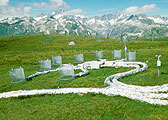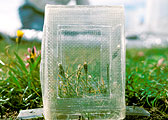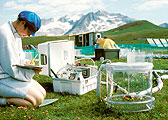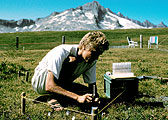 |
|
|
|
|
|
|
1 - In situ CO2-enrichment in alpine grassland near Furka Pass, at 2500 m. 2 - Herbivores (grasshoppers) in cages perform compensatory feeding on plants which grew under elevated CO2 (more biomass intake because of poorer quality). |
Plant photosynthesis depends on CO2. Given the reduced lesson on carbon relations has made it clear that there is no evidence that alpine plants are short of carbon. In order to test the C-limitation hypothesis, alpine grassland at 2500 m in the Swiss Alps was exposed to twice the current CO2 concentration for 4 seasons. The results confirmed the C-saturation hypothesis. Elevated CO2 caused:
It is concluded that the enrichment of the atmosphere with CO2 will exert little direct influence on late successional alpine biota. There is a possibility that small species specific reponse differences and plant-animal interactions will translate into longer term biodiversity effects. However, other environmental changes are likely to mask such CO2 effects. No data are available for alpine pioneer vegetation, which may be more responsive given their better access to nutrients. The indirect effects of atmospheric CO2-enrichment via enhanced greenhouse forcing will be discussed later. |
3 - Short term closure of open top chambers permits C-balance measurements: initial stimulation, but no change after 2 years. 4 - In situ respiratory signals to CO2-enrichment: no change. |
29 August 2011 |
||
| |
||



